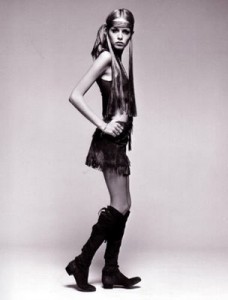 By Jae-Ha Kim
By Jae-Ha Kim
Chicago Sun-Times
July 8, 2003
If you want to know why it takes a woman so long to get dressed, try going shopping with her. Aesthetics aside, women have to deal with sizes that make no sense.
Welcome to the wacky world of women’s clothes, where more has become less when it comes to sizes.
As Americans have grown larger as a society, our clothing sizes–especially for women–have shrunk to cater to our vain need to wear the same size we did as teenagers, even though we’ve packed on more weight as adults. And one designer’s Size 10 is another’s Size 8 … or 6.
Couple that with vanity sizing–where the number will indicate a smaller size, even though it’s cut roomier to fit our meatier modern bodies than in our mothers’ generation–and you’ve got clothing chaos.
Enough is enough for a group of exasperated experts who’re taking steps to replace vanity sizing with something more regulated. These American size researchers–who are composed of clothing and retail manufacturers–are sponsoring SizeUSA to determine the real shape of American consumers.
They’re also hoping that correct sizing will help curb the $28 billion worth of merchandise returned each year due to poor fit.
SizeUSA drew its inspiration from the British, who completed their own sizing census last year.
“We’ve become tubular, which is not a popular message,” says Phillip Treleav-en, SizeUK’s project director. “No wonder 70 percent of people complain they can’t find clothes that fit them.”
An intriguing aspect of the SizeUSA data is that it will give manufacturers an opportunity to evaluate measurements by age, gender and ethnic background. J.C. Penney Co., one of the survey’s sponsors, is using the data to develop private-label lines targeted at specific groups, such as Latinos.
“One of the things we could do with the study is access data that allows us to establish a Hispanic size grid,” says Peter McGrath, senior vice president for product development. “[Then] we can better serve the niche markets.”
When it comes to size, ethnic makeup can make a difference. The average Asian and European behind is smaller than an American’s. Remember the stink during the 1988 Summer Olympics in Seoul, when Americans complained the stadium seats were too small?
Sixty years ago, the average American bottom was 14 inches wide. Today, it’s 2 inches wider, which is unfortunate since most toilet seats are just 14.5 inches wide. The average woman’s weight in the 1960s was 140.4 pounds. Today? Try 152.2 and rising.
The closest America came to standardized sizing was during the 1940s when the U.S. Army conducted a study of body types for men and women to supply uniforms for the war, according to the American Apparel & Footwear Association. But the system broke as designers sought to sell clothes to their own clientele and began sizing their clothes to their own version of the ideal shape.
This may explain why a woman can barely squeeze into a Size 6 pair of pants at Bebe, but she’ll swim in Liz Claiborne’s slacks marked the same size.
When manufacturers began mass producing ready-to-wear clothes in the late 19th century, sizing was based on age and ran from 14 through 20. Of course, this wasn’t a foolproof system either. Not all 20 year olds are shaped the same.
“The sizing issue isn’t simply that women don’t want to buy larger sizes,” says Linda Jo Connell, associate professor of consumer affairs at Auburn University. “There is research that shows women are receptive to that idea. But some designers don’t want that uniformity thrust on them. If their fit is good, they don’t want to be copied. It’s an issue of fit as a commodity, so they want to guard how they size certain pieces.”
Contributing: Wall Street Journal
Tell me about it. I wore a size 12 in HS and 40 lbs later I still wear a size 12. Hmmmmmm?
I never had proof, but I KNEW IT!!! Whats the point???
Whats the point???
Excellent observations. I’m also wondering if the opposite has happened to men’s sizes — especially shirts.
Victoria’s Secret does the vanity sizing too–but sorta in reverse.
It’s crazy! Nothing is consistent within a size either, I bought 4 of the same size shirt in different colors….1 fits too big, 1 fits just right and 2 won’t button. It’s so frustrating!! I wish there was just one size rule and all manufacturers stuck to it.
people have got bigger in bone structure and flab and the sizes have shifted to compensate. a uk 12 back in the day was 26 inch waist 36 inch hips now its 30 inch waist 39 inch hips, its not new though. I tend to stick to one or two shops that I know the sizes are true to me Kathy boring but easy